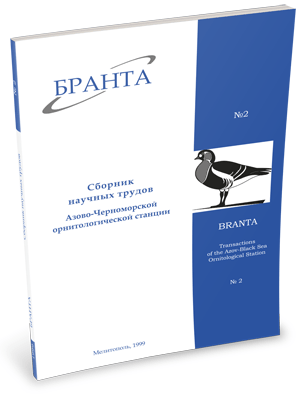
Transactions
of the Azov-Black Sea Ornithological Station



Breeding ecology of Little Tern in the North-Western Black-Sea coast
Vasilkov I.A.
Materials on breeding ecology of Little Tern (Sterna albifrons) were gathered in 1983-1985 in the Tiligul, Kuyalnik and Tuzlov groups of limans (the Odessa region). In total we found 1127 nests in 26 colonies or small groups and measured 600 eggs.
Outcomes: colony maps, density index for each colony, estimates of hatching synchronisation and data on diet of Little Tern. First birds arrived to the area on 15.04.85. and 21.04.86. Mass arrival started at the end of April – beginning of May. The birds came to the breeding grounds in small groups. The first complete clutches in 1983-1986 were found on 10, 11 and 18 of May respectively. The latest finding of a nest with two eggs (replacement clutch): 25 June of 1984. The species prefers to nest on open terrain without vegetation. It is in particular attracted by sandy or pebble soils along the liman banks on islets, piled dry marine algae on the banks and molluscs’ shells. The terns often lay eggs into abandoned nests of Avocets, Black-winged Stilts, and tracks of people, cows and horses. Nesting of the local population is rather unsynchronised. Timing of colony formation may vary from 1.5 to 3 weeks. Complete clutches usually contain 3, sometimes 4 or 5 eggs. Size of the last or replacement clutches is often reduced to two eggs or even one. Linear dimensions of eggs vary in the course of breeding period. The terns prefer to nest in disperse settlements or in small mono-species colonies of 10 – 145 pairs (41 pairs on average). They occasionally nest in mixed colonies with different Charadriiformes species. Colony size and structure depend on habitat type, predator pressure and food abundance near the colonies. In case of toss of the first nest or brood, part of the pairs (1.7 %) lay replacement clutches, whereas majority of these birds gather in small flocks and wander widely. Breeding success strongly depends on abiotic (precipitation, wind tides, storms etc.), biotic (habitat succession) and anthropogenic factors. Settlements of Little Tern suffer from severe influence of environmental factors. The species maintains population size by triggering some population mechanisms such as prolongation of breeding season, involvement of population reserve and decrease of colony density. The former may go as far as a very disperse nesting. Little Terns fish in shallow waters with clear, transparent water and little vegetation cover. In the Odessa region the birds are exclusively piscivorous. Adults take fish 10-65 mm long, whilst chicks are fed by smaller sized (10-30 mm) fingerlings. Breeding and foraging habitats are usually located nearby, apparently due to commonly sufficient supply of prey.
Read the paper in a PDF file